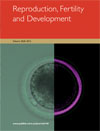Reproduction, Fertility and Development
Volume 24
Number 4 2012
It has long been thought that ewes need to be preconditioned by a period of complete separation from all rams before ram pheromones can induce ovulation. We showed that it is not separation but ram ‘novelty’ that is important. Separation for only a month enables ewes to respond to once-familiar rams, but induction of the full cascade of events leading to ovulation appears to be less successful.
The dynamics of protein tyrosine phosphorylation (PTP) in live spermatozoa during cryopreservation are not known. Using flow cytometry, we assessed the PTP in boar spermatozoa and the results provide the first quantitative evidence of dynamic changes in the subpopulation of boar spermatozoa undergoing PTP during cryopreservation. These findings may help in developing cryopreservation protocols for boar spermatozoa with better post-thaw function.
Females of many species store fertile spermatozoa in their oviducts for a long-time. We have identified a component of the oviduct: HSPA8 that when added to ram spermatozoa prolongs its shelf-life at ambient temperatures, meaning no ram need travel to meet his ewe to produce lambs in the future. This finding is likely to be of interest to agricultural ministries globally who seek to reduce the transport of farm animals to control disease outbreaks.
Nutritional state of the dam critically affects embryonic development and has lasting consequences for growth and lifetime health outcomes. Mechanisms controlling growth and differentiation of embryonic tissues in utero may be directly affected , or placental development may be primarily affected and indirectly limit nutrient availability to the embryo. Results of the present study are consistent with proposed benefits of feeding a specific nutrient supplement (l-arginine) during early pregnancy in the sow on placental vascularization and embryonic development.
A large group of men worldwide smoke cigarettes, which may adversely affect the health of their spermatozoa. This study was conducted in order to evaluate if zinc prevents damage of spermatozoa of rats exposed to cigarette smoke. The results showed that testosterone concentration, percentage of normal morphology, motility and DNA oxidative damage of spermatozoa were restored by zinc treatment.
Developmental competence of in vitro-produced bovine embryos is still compromised perhaps due to imperfect oocyte maturation. Therefore we analysed the structural changes during in vitro maturation of the bovine zona pellucida by polarisation light microscopy and identified a typical decrease in zona birefringence during maturation, which correlates with developmental competence. Thus, zona pellucida birefringence measurement is a new tool to assess correctness of in vitro maturation and developmental competence.
Spermadhesins are thought to play a prominent role in different aspects of animal fertilisation. The low purification efficiency and the incomplete characterisation of buck spermadhesins, as well as the multiplicity of their biotechnological applications, prompted us to establish an effective expression system to specifically produce the recombinant bodhesin Bdh-2 and to provide a technique for subsequent structural and physiological studies.
Little is known about the molecular mechanisms that regulate bovine trophoblast development. In current study, we demonstrated that impaired expression of two key regulatory proteins, E-cadherin and β-catenin along with defective β-catenin signaling activation occurs in trophoblast derived from bovine somatic nuclear transfer (SCNT). These deficiencies during embryo attachment could explain the insufficient placentation in the SCNT-derived fetus.
Hormonal induction is used to sample sperm from amphibians and fish in conservation breeding programs and aquaculture to be used fresh, or through cryopreservation to perpetuate genetic variation. We achieved improved sperm yield through comparing several hormones for induction, and provided new physiological insights to amphibian reproduction. These results will lower the costs and improve the efficiency of reproduction technologies for amphibians and fish.
Oxidative stress is, in general, pernicious for cells, but specific stressors, such as hydrogen peroxide, may have a beneficial effect on cell function, depending on the concentration used. In this study we exposed bovine sperm cells to different levels of hydrogen peroxide before fertilisation and found that spermatozoa exposed to sublethal levels of hydrogen peroxide can produce more blastocysts of better quality, depending on the diameter of the fertilised oocyte. This implies that stressed spermatozoa may improve subsequent embryo development in combination with careful selection of oocytes.
A boar epididymal sperm glycocalyx approach was used to correlate the degree of maturation of ejaculated spermatozoa with plasma membrane glycocalyx component changes. Complementary qualitative and quantitative procedures were performed in boar epididymal spermatozoa throughout the epididymis to identify specific molecular modifications of carbohydrate residues (intensity, location and proteomic changes). The present study provides new insights correlating the glycocalyx changes with the degree of sperm maturation.
Safe, steroid-free methods to control ovarian function in food-producing animals are needed. Aromatase inhibitors prevent the body from producing its own oestrogen and they have marked effects on the reproductive physiology of heifers. Results from the present study provide impetus for the development of an aromatase inhibitor-based protocol to control ovarian function in cattle.




